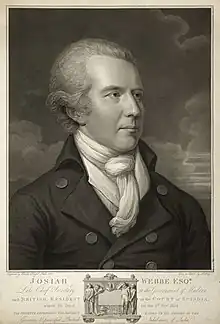
Josiah Webbe (April 1767 – 9 November 1804) was an English East India Company servant who worked as Chief Secretary at Madras and as a Resident at Mysore and later in the court of the Maharaja of Scindia.
Webbe was born into the colonial elite of Nevis as the son of George Webbe (1744-1804), a wealthy landowner and slaveowner, and Mary Fenton Dasent (1737-1818), whose grandfather John Dasent (1691-1754) and brother John Dasent (1734-1787) were both Chief Justice of Nevis.
He entered the service of the East India Company as a writer on July 26, 1783. His ability to deal with Indian languages made him popular. He advised against hostile actions towards Tipu Sultan which displeased Lord Mornington and the directors of the East India Company leading to his removal from the service of Arthur Wellesley. In 1803, he was posted Resident to the newly acquired kingdom of Mysore and the next year, he was posted by Wellesley to the Court of the Maharaja of Scindia in Gwalior. He died at Hussainabad on the banks of Narmada. A monolithic granite obelisk to him was erected at Srirangapatnam by Dewan Purnaiah,[1] and a monument by John Flaxman was installed at St. Mary's Church in Fort St. George.
Unmarried, Webbe left his wealth to his sister Fanny Francklyn (née Webbe) and her son Alexander Allan (1808-1868), who then took up the name and arms of Webbe in lieu of Francklyn.[2][3][4]
 Webbe Memorial - Obelisk at Srirangapatnam
Webbe Memorial - Obelisk at Srirangapatnam Monument by John Flaxman
Monument by John Flaxman
References
- ↑ Kennedy, Alexander (1823). "XXII. Account of the Erection of a Granite Obelisk, of a single Stone, about seventy feet high, at Seringapatam". Transactions of the Royal Society of Edinburgh. 9 (2): 307–316. doi:10.1017/S0080456800030921. ISSN 0080-4568. S2CID 129732467.
- ↑ "Fanny Francklyn (née Webbe)". Centre for the Study of the Legacies of British Slavery, University College London.
- ↑ Luard, C.E. (1901). Gwalior State Gazetteer. Volume I. p. 334.
- ↑ Cotton, H. E. A. (1924). "Thomas Hickey, Portrait Painter". Bengal Past and Present. 28: 153–154.